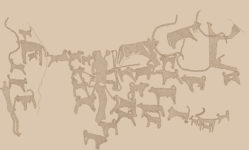During the Neolithic, hunting scenes were prevalent. They were fairly stereotypic, with one or more of a particular prey species in the center of the scene and a hunter standing behind, poised to fire his weapon. Typically, hunting dogs were engaging the prey by surrounding the animal and sometimes even biting its nose. In at least one scene, the hunter has some of his dog pack on leashes. These scenes inform about the species that were hunted, the hunting weapons used, how the dogs looked and were used, and so forth. The weapons were most often recurved bows or hand-held spears, but throwing sticks or boomerangs, as well as clubs may have also been employed. Individual hunters are common, but at times multiple men are shown on one panel. However, the men do not appear to be acting in conjunction with each other as they might in a communal hunt. On the other hand, the dogs do appear to be coordinated as they surround the prey. If the hunting scenes represent reality, then hunters may have actually dispatched lions with spears.
Wild animals continued to appear on petroglyph panels after the Neolithic, but more often as single images rather than the subjects of a hunting scene. This may imply that hunting was of reduced importance as pastoralism rose or that the wild species represented totem figures for certain clans.

















